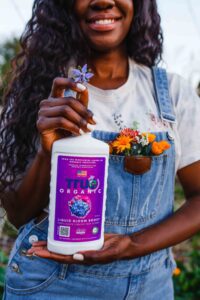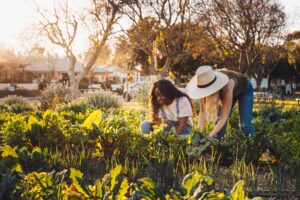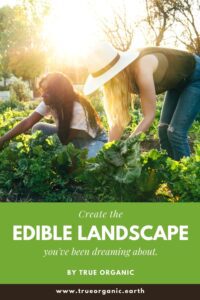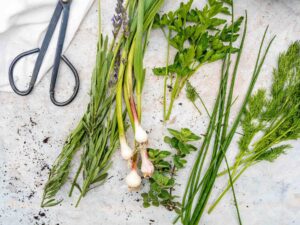MAY 15, 2021
Creating Your Edible Landscape
Some gardens are simply utilitarian, some are there to look lovely. How about an edible landscape that fills your senses and your table?
Beautiful and tasty!
Just because you’re increasing the functionality of your garden doesn’t mean you have to give up on aesthetics! In fact, some of these crops make a garden more colorful, textured, and lovely to look at.
Whether it’s your entire front yard, or just a corner of shared space, an edible landscape can transform any place into an outdoor oasis. Gardening for aesthetics and functionality can help us remember what’s most precious about nature: its ability to bring joy and sustenance into our lives.
What’s on the menu?
Now let’s check out what to plant in this oh-so-lovely garden of yours!
As always, be sure to research what kind of plants work for your climate zone and how much maintenance each kind of crop needs. Your personal selections will be unique and special to your location, your taste, and how much you’re willing to work in your edible landscape.
Herbs galore!
Herbs are quintessential edible landscape plants. Their textured leaves, easy maintenance, and attention-grabbing fragrances add so much life to your green oasis, and who doesn’t love having fresh herbs and flowers in your kitchen?
Choose hardier, perennial herbs for your edible landscape (be wary of basil and other delicate herbs in a landscaping situation—basil typically does better in a dedicated veggie garden and is a great companion plant). Bushy, shrubby herbs like rosemary, thyme, lavender, oregano, and sage are perfect and easy to integrate in most zones.
Lavender is the ultimate easy-care landscaping herb. Its gorgeous purple flowers and lovely scent make any garden or yard a more enjoyable, oasis-like spot. You can use both the leaves and flowers in baked goods like scones and cookies, steep it in a tea (perhaps with some mint), or simmer it in water for a sweet-smelling house.
Because they can grow quite large and they’re easy to shape and maintain, shrubby herbs work well along the landscaping border, or to create shape for your garden.
Another bonus: bees love flowering herbs! Support your local pollinators and cook deliciously seasoned food.
 Onions, Garlic, Chives
Onions, Garlic, Chives
Add some flavor to your meals and your garden with this zesty plant family. These easy-to-grow plants have unique blooms and bright stalks that make an edible landscape pop with life.
Garlic is an edible landscape superhero: you can harvest it twice, once for the stems (or scapes) and once for the bulb! Garlic scapes—the plant’s adorable green stem and flower bud—can be trimmed off in early spring, as they start to curl in. Leave the bulb in the ground until later in the summer, when it’s ripe with flavor.
Bonus: Hungry outdoor critters don’t really like to chew on these stinky greens.
Berries
Strawberries are a perfect edible landscape resident, with their small size and bright berries and adorable white flowers. They can be grown in containers, if you want to give your edible landscape a little extra style.
For larger yards, blueberry bushes are a beautiful and delicious addition.
For really big landscapes, blackberries and raspberries are for the more adventurous. Brambles like these two berry plants can quickly grow out of control, though, so be sure you’re ready to commit to a regimen of thorny pruning before you go all-out on the berry front.
Edible Flowers

Try begonia (can taste a bit bitter), calendula, nasturtium (beautiful on salads!), borage, and violet petals (really great for decorating baked goods). A little goes a long way with these edible beauties.
Just like in your vegetable garden, choosing organic fertilizer to nourish your landscape is essential. It’s especially important when it comes to any edible plant that will end up on your table, like those flower petals that could end up on your friend’s next birthday cake. We’ve got you covered with our TRUE Liquid Bloom Boost, a safe, effective flower food that nourishes both plant and soil.
As your flowers blossom, be sure to appreciate the fluttering pollinators that you’ve invited into your landscape. You’re doing great work supporting biodiversity, as well!
What about veggies?
Vegetables can be a bit trickier to incorporate into an edible yard or landscape. Reserve your prized veggies for a spot where you can nurture them with precision when it comes to spacing, soil maintenance, and specific tending.

And leafy greens are sooo good for you!
Try curly kale, purple-tinted Redbor kale, Red Russian kale, and vibrant rainbow chard for spots of color and texture in the garden.
Design tips
Let your dreams blossom! Get creative when you design your edible landscape. Needs some inspiration? Take a stroll through our Edible Landscape Ideas Pinterest board and see what strikes your fancy. Spark your full range of gardening creativity with our entire Pinterest board collection!
Unlike a veggie garden or raised bed garden your edible landscape can be any shape or style you like. Maybe you have a patch of side-yard that gets perfect light, or a front lawn that you’re ready to turn into something more sustainable. You don’t even need to plant in rows! Time to garden outside the box.
Pathways
Designing a central path made of rocks, brick, or packed dirt gives your garden space structure and flow. That can be as simple as leaving space between plant groupings or as fancy as laying down stepping stones to create a clear path.
Remember, you’ll want to get in there and harvest your edible landscape! Make sure to leave space for walking, kneeling, gathering, and pruning.
Stone borders
Placing larger-sized stones at the edge of plant groupings helps your landscape feel neat and tidy, and can help prevent weeds from taking the place over.
Map it out
Planning before planting: it’s the responsibility of any gardener. It’s especially important if your mission is to create an attractive, edible yard!
Measure your space, then get crafty with paper and pencil. Think about which plants will look nice next to each other, who needs more space, and who needs to be in the spotlight (aka full sun!). Where can you use rocks, pottery, maybe even a cute little bench?
Having a plan will help you get the most out of your edible landscape.
Mix it up
Texture, color, scent, size. Create a diverse cornucopia of all these characteristics and your landscaping creation will be a treat for the eyes…and nose.
Choose a few plants with flowers, some with spiny leaves, some fluffy ones. Short ones, tall ones, twirly, swirly, and everything in between!
Beauty in sustainability

When you admire the pollinators fluttering around your yard, inhale the fragrance of a diverse landscape, and watch buds bloom, you’ll really feel how connected you are to the land we live on—and the land that feeds us.
Show us your True Organic Plants
#GrowWithTrue
www.trueorganic.earth

 Onions, Garlic, Chives
Onions, Garlic, Chives